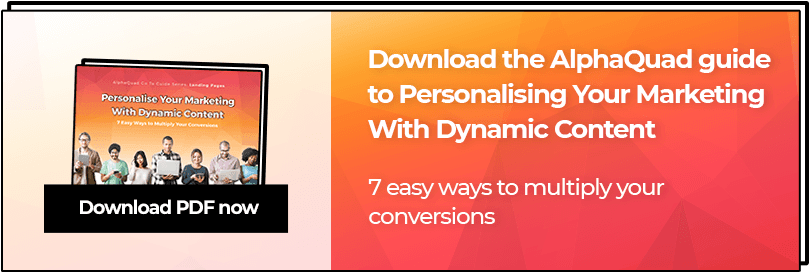21 tips to write effective online copy that converts
Are you getting lots of visitors to your website but not managing to persuade them to become customers? If so, the most likely cause could be the quality of your online sales copy.
Whether your website sells products or services, the content you include on your web pages is the only place that customers can get the information they need to make that all important buying decisions – so it’s up to you to inform and convince them.
Writing good sales copy doesn’t have to be difficult, as long as you are able to put yourself into the mindset of your customer and work out what it is they will want to know. Follow our top tips in order to make sure you are writing good online sales copy, and watch your conversion rate steadily improve.
1. Love your product or service
This is probably the most important, which is why it has been included first. If you aren’t 100% behind your product or service then it is impossible to write good sales copy for it. Before you even start working on your product pages, make sure you are completely clear on how your product or service is better than your competitors, and then selling it will be that much easier.
2. Headlines sell
If you don’t capture people with the headline of your page, they are unlikely to keep reading in order to find the benefits of your products or services, regardless of how good they may be. It takes no effort at all for someone to disappear from your website. With one click they are gone, and unlike a real shop they won’t have time for something to catch their eye and draw them back on the way out. This means your headline must do two things: attract their attention and then hold their interest. Once this is achieved then they will keep reading, which is where the rest of your copy comes in. Some of the options you could take with your headline are:
Mention a major benefit: ‘Reduce your spend on petrol by £200 per month’
Mention your target audience specifically: ‘Drivers! You could be spending less money on petrol’
Use a testimonial: “We saved £200 a month on petrol”
Ask a question: ‘Would you like to spend less money on petrol?’
3. Lead with just one message
Once you have grabbed the reader’s attention and interest with the headline, the first paragraph must create a desire for the product or service you are offering. You will achieve this by focusing this first paragraph on the one major benefit that this product or service offers; what it will do for your customer that no other product or service can. If you craft this paragraph well, then you will have already achieved buy-in from the customer, and the rest of the benefits that you have will just confirm to them that this is the product or service that they have been looking for.
4. Talk to the customer directly
Use the words ‘you’ and ‘your’ when describing what the product can do for the customer so they start to see themselves with the product, on the holiday, in the car – or whatever it may be that you are selling. Once a customer can see the product in their lives, they are much more likely to buy it.
5. List your product or service benefits as well as features
When writing sales copy, at the forefront of your mind should be “what’s in it for the customer?”. Whenever you are including a benefit in your copy, ask yourself why a customer should care about it, and then add this too. For example don’t just say a product is ‘fast to install’ add that it is ‘fast to install giving you more free time for the rest of your day’s to-do list’. Being fast to install is just a feature of the product, giving the customer more time is a clear benefit to them – and far more persuasive.
6. Use longer copy
A recent test by conversion optimization case study website Behave.org, found that longer sales copy increase conversions by 62%. When purchasing online, the only details customers have about the product is what you give them in the sales copy, so when looked at like this, it makes sense that the more information you give them, the more likely they are to purchase. The key with long sales copy is to make sure that it is easily digestible, so the reader can find what it is they want to know in order to make the buying decision. Make sure that your page includes sub-headings separating the information you have for the reader (such as description, features, dimensions, ratings and reviews, gallery of images and the price) so that they only need to scan down the page to find what they are looking for.
7. Use bulleted lists
Internet readers don’t tend to read a page word for word, so you will need to present your copy in an easily digestible way. Bullet points are great for this, as most readers respond well to lists as they are simple to digest. The key with sales copy is to stick to the rule of seven – you should have no more than seven items in a list or it becomes too long for a reader to take in the information presented. The first and last bullet points are also best remembered, so keep your best sales points in these positions.
8. Make your product or service stand out from the competition
The words that you use to describe your products benefits are important too, as they need to make it stand out above all others. Your product or service needs to be offering something new (or better) in order to sell well, so make sure that the reader knows this. Here are a few words that we have found to work in the past:
- Breakthrough
- Unparalleled
- Brand new
- Emerging
- Innovative
- Proven
- Edge
9. Use words to help them justify the purchase
Going back to the earlier point about talking to the customer directly, you need to encourage the reader to make an emotional connection with your product or service so they justify the purchase in their minds. Many people are put off a product or service because there is a doubt in the back of their mind about whether they really need it; change this doubt into a certainty that they really want it and you will make yourself a sale. To achieve this use words such as ‘imagine’ and ‘consider’ to help them visualise themselves with the product or service and what it will do for them.
10. Consider the objections customers may have, and then overcome them
Very rarely will someone land on your product page and spend their money without considering it first. You need to be prepared to counter the objections they may have in your sales copy. Some common objections to making a purchase include:
- It’s too expensive
- It’s too complicated to use
- I don’t need it
Once you have considered all of the possible objections to your own product or service, counter them within your copy. If you think people will find the price too high, include in your product description examples of the return on investment (see our point below for some caution here) or relate it to something they often spend money on (‘It is the price of a daily cup of coffee’).
11. Be honest
Don’t make exaggerated statements about your products and services if they aren’t true, or are only true for a very small number of people. Focus on what the product does for most people, so when they buy it they get what they expect. This way you are much more likely to get repeat business from them and the ratings and testimonials that you need to help persuade new customers too.
12. Be definite
Don’t use words like ‘could’, ‘may’ or ‘should’ because if you aren’t sure then a customer won’t be either. At this point we would refer you back to the point we made at the beginning of this post, if you don’t love your product or service and feel confident enough in it to make guarantees of what it ‘will’ do, then you aren’t yet ready to sell it.
13. Include buy buttons in more than one place on the page
Some people need to read more information than others before making the decision to buy, so make sure your landing page caters for both by including more than one ‘buy’ button on the page. I would recommend including three – one at the top, one after the list of benefits and one at the end. Make sure you also set up event tracking on all three so you can monitor which button is used most often.
14. Include lots of images
This is particularly important when selling products, but is often relevant for services too. When buying online it isn’t possible to see or feel what you are purchasing, so images are essential to sell the item. Make sure that your photos are clear, can be enlarged so customers can take a close-up view of the products, and the photos show off the products from multiple angles.
15. Give the reader a call to action
At the end of the sales copy let the reader know what they should do next – add a buy button, quote button or contact button to encourage them to continue their journey with you.
16. Make sure you have a visible phone number
People like to know that if they have a problem, there is always someone they can talk to, so make sure that you backup the products and services you are selling with a telephone number. Providing a telephone number tells customers they aren’t buying from a website, they are buying from people – and they can speak to those people if they need to.
17. Provide a guarantee
One of the main reasons that people don’t purchase a product or service, both on and off-line, is because they don’t have confidence in it. You can remove this barrier by providing a guarantee, so that even if there was a problem they wouldn’t lose their money.
18. Include testimonials, ratings and reviews
We all like to read recommendations from other people, so make sure that you provide the option for previous customers to leave a rating for your product and a chance to explain the reasons behind it. This rating can also be used to improve your Google page ranking too (see our blog post on rich snippets to understand more). Don’t let the fear of negative reviews put you off, as this is still a useful way to gather feedback. If someone leaves a negative review, respond to it and see if you can help them to fix whatever their problem is. If a customer does reveal a genuine issue with your product then you will need to fix it – and make sure that you include a response on the website when you have. Remember that ratings and reviews are one of the few features of online shopping that aren’t available in regular shops – so make sure you use them!
19. Even if they don’t buy, get them to do something
At the end of the page include links to follow you on Twitter and Instagram, sign up to your newsletter or become a fan on Facebook. This way, even if someone hasn’t quite made the decision to buy, they are still going to be interacting with you, and you may well get another opportunity to persuade them later!
20. Make sure your sales page looks good and is easy to read
This may sound like an obvious one, but it is surprising how many websites use an illegible font that cause people to work hard just to find out about the product or service. Online shopping is made easier by the search button – if people struggle to get what they need from your website they will just go back to the search engine and find a website that gives them the information they need. Back up your fabulous product or service with a well-designed website that really shows it off.
21. Check your spelling and grammar
Once you have finished writing your sales copy, re-read it and make sure that there aren’t any spelling or grammatical errors in it. If you are careless with your spelling it creates a bad impression of what your products and services will be like. See our blog post on sloppy copy for more information about what poor copy can do to your sales figures
By implementing these tips and fine-tuning your product pages you will see your conversion rate improve (and if it doesn’t you will need to have another look at your product or service and determine why it is that people aren’t convinced by it), but it doesn’t stop there.
Even if you have a good conversion rate, always make small changes to the page and test if this makes a difference to your sales. Conversion optimisation is a vital component to getting the best out of your sales copy, so don’t sit back once conversions improve and assume you have done all you can; modify the pages regularly and track the response you get to see if you can improve it even further.




